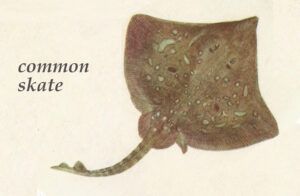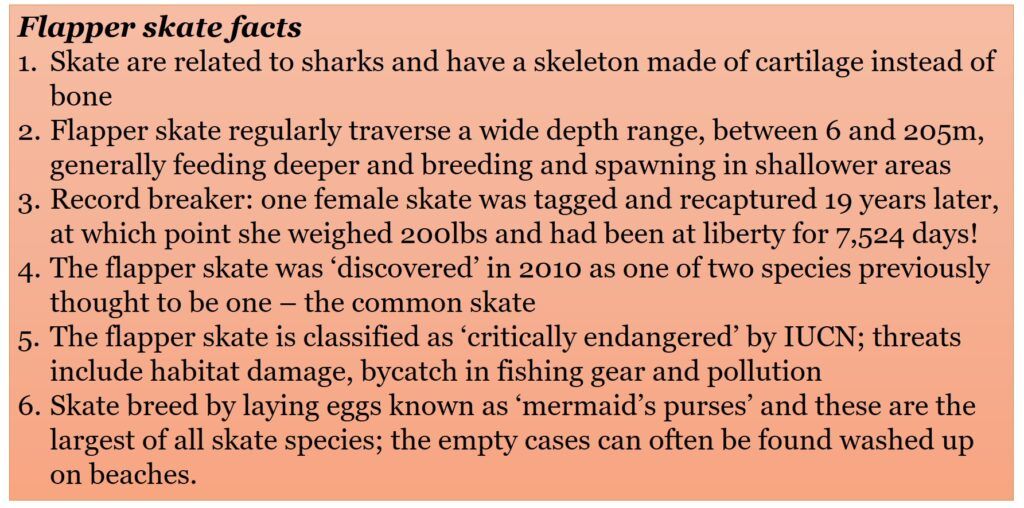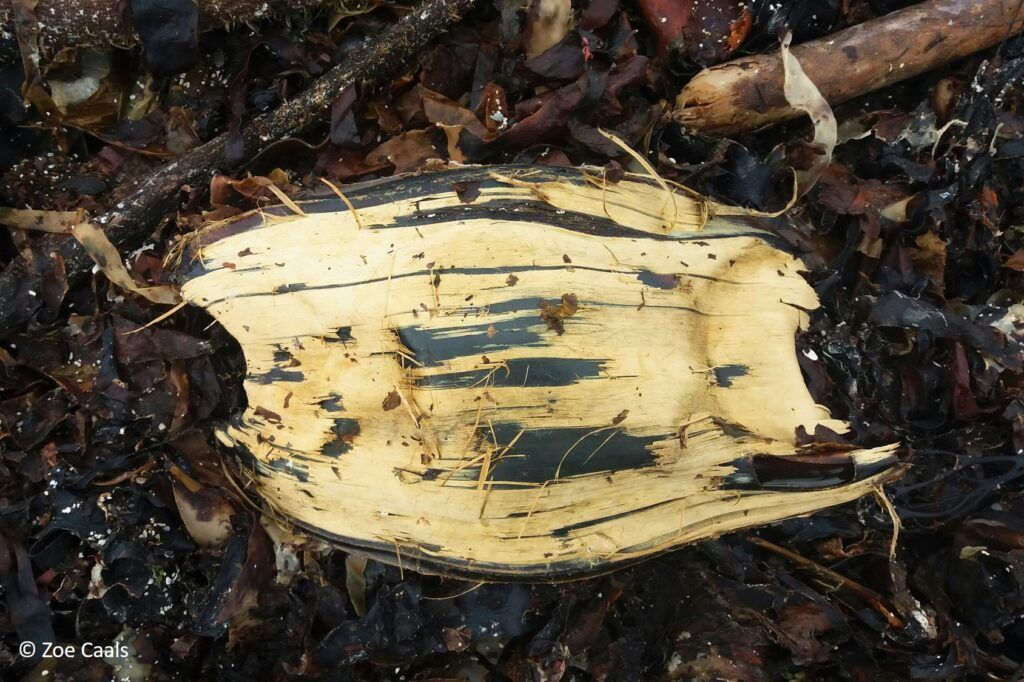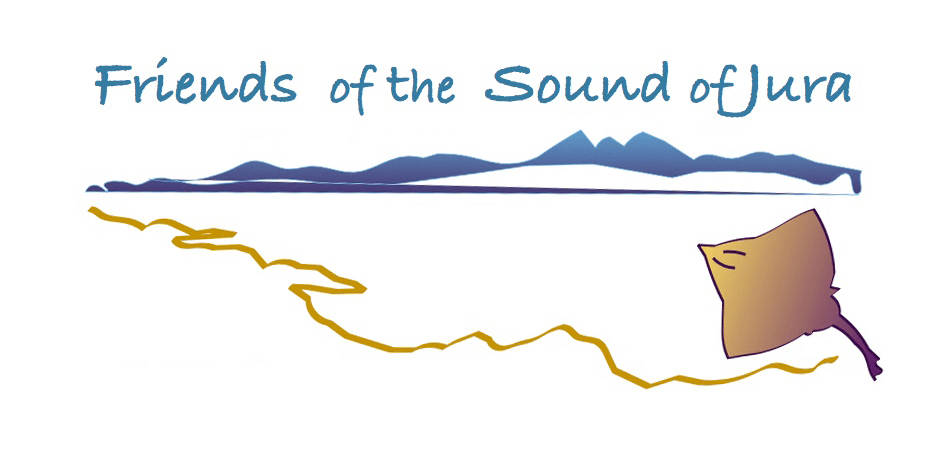Did you know that Scotland is home to 3-metre long wild animals that are at greater risk of extinction than the giant panda? John Aitchison, from Friends of the Sound of Jura, a coastal community group based in Knapdale, mid-Argyll, delves into the mysterious and little known flapper skate…
Introduction
Flapper skate (Dipturus intermedia – previously named common skate) are found from shallow coastal waters down to depths of 600 m, but mainly above 200 m. They are the world’s largest skate, reaching up to three meters in length. They grow and reproduce slowly, not reaching maturity for at least 11 years. They were once widespread over large areas of coastal, continental and insular shelf waters of the northeast and east central Atlantic, from northern Norway and Iceland, throughout the North Sea, to the western Mediterranean and northwest Africa. The large size of their young from birth means that they can be caught in most types of fishing net. It is now illegal to target or land these skate, but by-catch (incidental catch in fishing gear) and historic targeted fisheries have already eradicated them from much of the area between the Mediterranean and the English Channel. They have nearly vanished from the North Sea and the Irish Sea as well. Their remaining known strongholds are in Argyll, on the west coast of Scotland, centered around Loch Sunart, the Sound of Mull, Firth of Lorn and Sound of Jura. The Loch Sunart to Sound of Jura Marine Protected Area (MPA) was created in 2014 to protect the area’s deep, glacier-carved seabed troughs and the flapper skate that live in them. They have also been recorded around the Northern Isles of Orkney and Shetland – areas that are not yet designated for skate due to lack of data.
Finding out more about the flapper skate
Tagging studies on Argyll’s flapper skate began in the 1970s, and continue today through the Scottish Shark Tagging Programme, use of photo-ID to census the skate and a new three-year research project by St Andrew’s University. These tagging studies have shown that flapper skate can be extremely faithful to particular areas, known as ‘site fidelity’. Anglers were instrumental in the creation of the MPA, helping to collect the data needed to prove where the skate live, and are now helping to census the skate by collecting and matching pictures of their distinctive spot patterns.
Egg cases washed ashore throughout the MPA show that flapper skate breed in this area. So far no nursery grounds have been identified but the deep, glacier-carved channels between the islands and mainland of Argyll’s coast form a natural marine highway.
The Scottish Government has funded a new study of the flapper skate in the MPA, led by Dr James Thorburn (St Andrew’s University). Dr Thorburn is interested in the apparent pattern that male flapper skate migrate into this area from the south, around Northern Ireland, to breed with females resident in this area, and that young skate move further north within the MPA, perhaps to avoid predation by the adults.
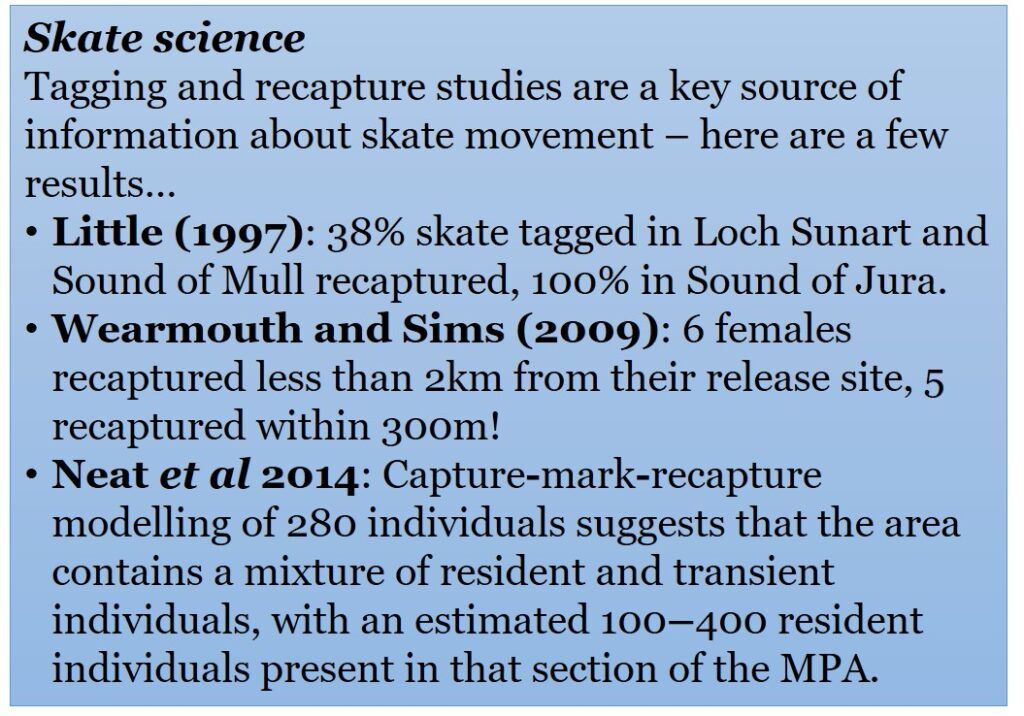 However, skate that live or move outside the MPA are not protected from by-catch or harm caused by bottom-towed fishing gear. In many cases their locations are not yet known. More urgently needs to be done to protect this endangered species beyond the current boundaries of the Loch Sunart to Sound of Jura MPA. As the OSPAR Background Document for common skate (2010) states, the conservation objectives of measures “should be to protect all remaining animals and populations in order to allow these populations to rebuild, and to enable the species to recolonise its former range. This requires the identification and protection of remaining populations and their habitat and the minimisation of target and by-catch mortality throughout the OSPAR Area”. The Friends of the Sound of Jura have been engaging with Dr Thorburn and with Scottish Natural Heritage to consider extending the study area beyond the MPA boundary, which was determined by limited data on flapper skate distribution that was available at the time.
However, skate that live or move outside the MPA are not protected from by-catch or harm caused by bottom-towed fishing gear. In many cases their locations are not yet known. More urgently needs to be done to protect this endangered species beyond the current boundaries of the Loch Sunart to Sound of Jura MPA. As the OSPAR Background Document for common skate (2010) states, the conservation objectives of measures “should be to protect all remaining animals and populations in order to allow these populations to rebuild, and to enable the species to recolonise its former range. This requires the identification and protection of remaining populations and their habitat and the minimisation of target and by-catch mortality throughout the OSPAR Area”. The Friends of the Sound of Jura have been engaging with Dr Thorburn and with Scottish Natural Heritage to consider extending the study area beyond the MPA boundary, which was determined by limited data on flapper skate distribution that was available at the time.
The site fidelity of flapper skate may partly explain why they have become extinct in areas where fishing pressure is intense. Their rapid decline and limited ability to recolonise areas from which they have disappeared, prompted IUCN to add flapper skate to the Red List of Threatened Species as Critically Endangered globally. This is the last stage before extinction; meaning that flapper skate face a greater risk of vanishing forever than giant pandas.
Protection for the Flapper Skate – the MPA and beyond
Flapper skate are included in the UK’s Biodiversity Action Plan and on the OSPAR Convention List of Threatened and/or Declining Species and Habitats As a significant proportion of the UK population lives in Scottish waters, Scotland has a particular responsibility for this species, and the flapper skate is listed as a Priority Marine Feature in Scottish waters. Although individual skate have no legal protection, they cannot be targeted by fishing boats, retained, trans-shipped or landed, under the Sharks, Skates and Rays (Prohibition of Fishing, Transhipment and Landing) (Scotland) Order 2012. All skate caught must be returned to the sea unharmed where possible.
When the Loch Sunart to Sound of Jura Marine Protected Area was created by the Scottish Government, it defined the boundaries of the area within which conservation measures would be considered. A Conservation Order was then enacted in 2016, to protect flapper skate and their eggs inside the MPA from harmful forms of fishing, such as bottom trawling and dredging (mainly for scallops and prawns). As shown on the map below, there are a mix of permanent and temporal restrictions to protect the flapper skate. The closure of the Firth of Lorn SAC to scallop dredges in 2008 has also probably helped to protect the local skate population.
Although contravening this Order carries a fine of up to £50,000, and on conviction on indictment, to an unlimited fine, concerns of possible illegal dredging within the MPA are being investigated. More resources are needed to prevent any illegal fishing. Coastal community groups and others have begun to publish and circulate information on the fisheries restrictions, with advice on how to collect and report evidence of illegal fishing within the MPA. Maps and KIPPER guides are available here
The map below shows the management measures for fishing within the MPA, that allows dredging to take place in nine areas within the MPA (hatched on the map). There are seasonal closures in four of these areas, where fishing can only take place between 1st October and 31st March.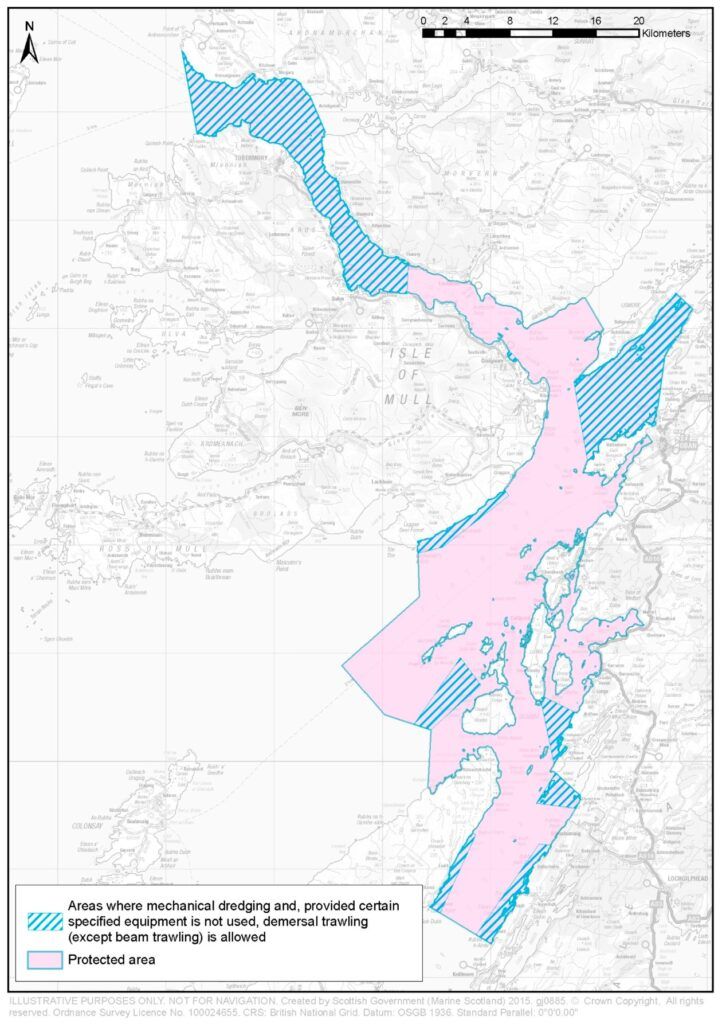
Looking to the future
There are few opportunities to create jobs in small coastal communities like ours, but the MPA can help. Tourism is booming. People already come to this area to enjoy its landscape and rich cultural history. If rooted in appropriate guidance and best practice, such as the Scottish Marine Wildlife Watching Code and the WiSe scheme, there could be more sustainable jobs in showing visitors the spectacular wildlife above and below water, and in recreational catch and release angling for the amazing flapper skate, which also contributes to science and their conservation. Each skate angling charter boat already brings around £60,000 per year to the area; there are three such boats at the moment.
The future is all about education. At the heart of small communities like ours there is usually a primary school. Fishermen using sustainable creel-fishing methods sometimes bring seabed animals for the kids to see. At the annual Tayvallich weekend, the Friends of the Sound of Jura has a stall, with games and prizes based on finding flapper skate. Public events have filled the village halls on the island of Jura and on the mainland; with talks by an underwater photographer who amazed us with his images and stories of this hidden world right next door to our homes, and on the latest research on flapper skate. As a result, one boy asked for his birthday presents this year to be donations to the Shark Trust.
There has been a profound change of attitude towards marine conservation in this area since the 1990s. Then, a plan to designate Loch Sween as Scotland’s first Marine National Nature Reserve was viewed with suspicion by the same coastal community that is now embracing the Loch Sunart to Sound of Jura MPA. Loch Sween itself is of course now also a nature conservation MPA. There is a growing awareness that all is not necessarily well in the sea and that it is not right to ignore this, just because we cannot see beneath the surface. In Scotland, MPAs are an idea whose time has come. We want to make sure that our MPAs are a beacon, to show other coastal communities here and around the world what is possible when the people who live by the sea prove that they care.
A bit about Friends of the Sound of Jura
Friends of the Sound of Jura is a coastal community group, based in Knapdale, mid-Argyll. Knapadale has the Loch Sunart to Sound of Jura on one side and the Loch Sween MPA on the other. Our community is keen to be involved in the management of these areas, to help with and benefit from their conservation.
We are involved in citizen science projects, including helping government agencies by surveying the seabed for benthic animals that are harmed by some fishing methods, collaborating with the award-winning Seasearch underwater citizen-science project, as well as by fish farm pollution and waste. This is allowing us to contribute to the important review of the protection these animals receive – animals such as northern sea fans and the rare coralline algae, maerl. Members of the groups have also attended courses and workshops to learn about seashore surveys and seaweed cultivation and harvesting, which could create sustainable jobs. We are gaining knowledge all the time, learning on behalf of our community and feeding back this information to help us make informed decisions together.
Get in touch with Friends of the Sound of Jura:
https://www.friendsofthesoundofjura.org.uk/
https://www.facebook.com/friendsofthesoundofjura/
@TheSoundOfJura
References
Dulvy, N.K., Notobartolo di Sciara, G., Serena, F., Tinti, F. & Ungaro, N., Mancusi, C. & Ellis, J. 2006. Dipturus batis. In: IUCN. 2009. IUCN Red List of Threatened Species. Version 2009.1.
Wearmouth, V.J., Sims, D.W. 2009. Movements and behaviour patterns of critically endangered common skate Dipturus batis revealed by electronic tagging. Journal of Experimental Marine Biology and Ecology 380: 77-87.
Wearmouth, V.J., Sims D. W., Movement and behaviour patterns of the critically endangered common skate Dipturus batis revealed by electronic tagging. 2009.
Journal of Experimental Marine Biology and Ecology 380 77–87
Neat, F., Pinto, C., Burrett, I., Cowie, L., Travis, J., Thorburn, J., Gibb, F. and Wright, P.J. 2014. Site fidelity, survival and conservation options for the threatened flapper skate (Dipturus cf. intermedia) Aquatic Conserv: Mar. Freshw. Ecosyst.
Little, W. 1995. Common skate and tope: first results of Glasgow Museum’s tagging study. Glasgow Naturalist 22, 455–466.
Little, W. 1997. Common skate in the Sound of Mull. Glaucus 8, 42–43.
Little, W. 1998. Tope and skate tagging off west Scotland: Part 2. Glaucus 9, 36–38.
Walker, P.A. and Hislop, J.R.G. 1998. Sensitive skates or resilient rays? Spatial and temporal shifts in ray species composition in the central and north-western North Sea between 1930 and the present day. International Council for Exploration of the Seas. Journal of Marine Science 55: 392-402.

